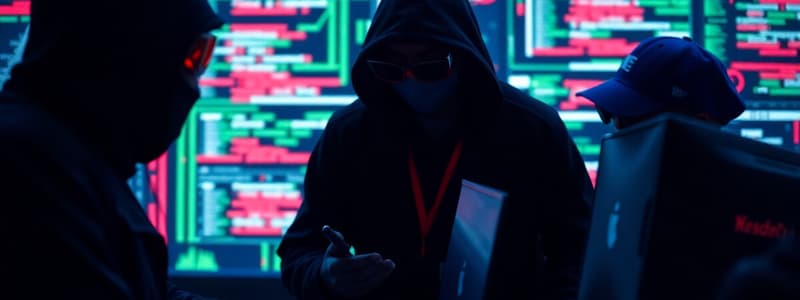Podcast
Questions and Answers
What is the primary responsibility of a Tier 3 SOC Analyst?
What is the primary responsibility of a Tier 3 SOC Analyst?
- Conducting in-depth incident analysis
- Threat hunting and developing preventive measures (correct)
- Assigning alerts to Tier 1 Analysts
- Initial analysis and incident confirmation
In a typical SOC structure, which tier is responsible for in-depth analysis and recommending remediation steps?
In a typical SOC structure, which tier is responsible for in-depth analysis and recommending remediation steps?
- Tier 2 (correct)
- Tier 4
- Tier 3
- Tier 1
If a Tier 1 Analyst determines a security alert is a false positive, what is the next step for the SOC?
If a Tier 1 Analyst determines a security alert is a false positive, what is the next step for the SOC?
- Escalate the issue to Tier 2 for a deeper analysis
- Close the ticket without further action (correct)
- Implement preventive measures immediately
- Notify the Tier 3 Analysts for further investigation
What follows the triaging of a security alert in a SOC?
What follows the triaging of a security alert in a SOC?
Which of the following is NOT a responsibility of Tier 2 Analysts?
Which of the following is NOT a responsibility of Tier 2 Analysts?
What is the primary function of a SIEM platform?
What is the primary function of a SIEM platform?
Which phase in the Incident Response Lifecycle focuses on preparing for potential incidents?
Which phase in the Incident Response Lifecycle focuses on preparing for potential incidents?
What role does SOAR play in a Security Operations Center?
What role does SOAR play in a Security Operations Center?
Which statement is true regarding the structure of a Security Operations Center?
Which statement is true regarding the structure of a Security Operations Center?
In the context of incident response, what is the focus during the Detection & Analysis phase?
In the context of incident response, what is the focus during the Detection & Analysis phase?
What is the primary goal of the containment phase in the Incident Response Lifecycle?
What is the primary goal of the containment phase in the Incident Response Lifecycle?
During the Recovery phase, which action is primarily emphasized?
During the Recovery phase, which action is primarily emphasized?
What is a critical component of Post-Incident Activity in the Incident Response Lifecycle?
What is a critical component of Post-Incident Activity in the Incident Response Lifecycle?
Which of the following best describes the role of indicators and precursors in incident analysis?
Which of the following best describes the role of indicators and precursors in incident analysis?
Which statement about the Incident Response Lifecycle is false?
Which statement about the Incident Response Lifecycle is false?
What is a primary reason organizations may view cybersecurity as a hindrance?
What is a primary reason organizations may view cybersecurity as a hindrance?
What characterizes state-sponsored threat actors?
What characterizes state-sponsored threat actors?
What factor contributes to the greater need for cybersecurity in technology-dependent societies?
What factor contributes to the greater need for cybersecurity in technology-dependent societies?
Which statement accurately reflects the nature of threat actors in cyberattacks?
Which statement accurately reflects the nature of threat actors in cyberattacks?
What is a consequence of implementing more cybersecurity controls in organizations?
What is a consequence of implementing more cybersecurity controls in organizations?
Why may some organizations resist adopting stringent cybersecurity measures?
Why may some organizations resist adopting stringent cybersecurity measures?
What role does the presence of cyber units in first-world countries play in cybersecurity?
What role does the presence of cyber units in first-world countries play in cybersecurity?
What might be a misconception about cyber threats in organizations?
What might be a misconception about cyber threats in organizations?
Flashcards
Cybersecurity
Cybersecurity
The practice of protecting computer systems, networks, and data from unauthorized access, use, disclosure, disruption, modification, or destruction.
Cyberattacks
Cyberattacks
Harmful actions aimed at disrupting, damaging, or gaining unauthorized access to computer systems, networks, or data.
Threat Actors
Threat Actors
Individuals or groups behind cyberattacks, driven by various motivations like financial gain, espionage, or disruption.
State-sponsored Threat Actors
State-sponsored Threat Actors
Signup and view all the flashcards
Availability vs. Security
Availability vs. Security
Signup and view all the flashcards
Cybersecurity Controls
Cybersecurity Controls
Signup and view all the flashcards
Cybersecurity as a Hindrance
Cybersecurity as a Hindrance
Signup and view all the flashcards
Why is cybersecurity important?
Why is cybersecurity important?
Signup and view all the flashcards
What is a SOC?
What is a SOC?
Signup and view all the flashcards
SOC Tiers
SOC Tiers
Signup and view all the flashcards
SOC Ticketing System
SOC Ticketing System
Signup and view all the flashcards
SIEM
SIEM
Signup and view all the flashcards
Tier 1 SOC Analyst
Tier 1 SOC Analyst
Signup and view all the flashcards
Threat Hunting
Threat Hunting
Signup and view all the flashcards
SOAR
SOAR
Signup and view all the flashcards
Incident Response Lifecycle
Incident Response Lifecycle
Signup and view all the flashcards
Preparation
Preparation
Signup and view all the flashcards
Detection & Analysis
Detection & Analysis
Signup and view all the flashcards
Containment, Eradication & Recovery (CER)
Containment, Eradication & Recovery (CER)
Signup and view all the flashcards
Post-Incident Activity
Post-Incident Activity
Signup and view all the flashcards
Using Various Sources for Analysis
Using Various Sources for Analysis
Signup and view all the flashcards
Precursors and Indicators
Precursors and Indicators
Signup and view all the flashcards
Study Notes
Introduction to Cybersecurity Operations
- The presentation covers cybersecurity dangers, threat actors, and security operation centers (SOCs).
Cybersecurity Threats & Dangers
- 2023 saw a 72% increase in data breaches compared to 2021.
- There were 2,365 cyberattacks in 2023, impacting 343,338,964 victims.
- Data breaches cost approximately $4.88 million on average in 2024.
- Email is the most common vector for malware, comprising about 35% in 2023.
- Ninety-four percent of organizations reported email security incidents.
- Business email compromises caused over $2.9 billion in losses in 2023.
Cybersecurity Threats & Dangers - Singapore Context
- Over 8 in 10 organizations in Singapore experience a cybersecurity incident annually.
- Businesses experience cybersecurity incidents more frequently than other organizations.
- The incidents affect businesses, resulting in disruption, data loss, and reputational damage (48%, 46%, and 43% respectively).
- Non-profit organizations face similar impacts, including 60% data loss and 44% reputational damage.
- The increasing use of technology increases the need for cybersecurity.
Threat Actors
- Cyberattacks originate from threat actors, which can be individuals or groups.
- The root causes of cyberattacks are often driven by motivations including financial gain, trade secrets, and global politics.
- Common threat actor types include amateurs (script kiddies), hacktivists (those protesting politically), financial motivated actors, and state-sponsored actors (paid by governments).
Security Operations Center (SOC)
- SOCs are designed to monitor and respond to cybersecurity incidents.
- A typical SOC structure consists of levels of analysis. These are frontline analysts (Tier 1), incident responders (Tier 2), and threat hunters (Tier 3).
- Tools like security information and event management (SIEM) platforms help with monitoring, aggregating, and analyzing logs.
- Security orchestration, automation, and response (SOAR) platforms automate incident investigations and responses.
Incident Response Lifecycle
- The incident response process involves several phases: preparation, detection & analysis, containment, eradication & recovery, and post-incident activity.
- Preparation involves ensuring the necessary tools and resources are available.
- Detection & analysis involves identifying potential indicators from a variety of sources.
- Containment, Eradication & Recovery involves isolating threats, and restoring systems.
- Post Incident Activity involves learning and improving to prevent reoccurrences.
Studying That Suits You
Use AI to generate personalized quizzes and flashcards to suit your learning preferences.




